Advertisements
Advertisements
प्रश्न
Choose the correct option.
Select the WRONG statement.
विकल्प
Smaller angle of prism is recommended for greater angular dispersion.
Right-angled isosceles glass prism is commonly used for total internal reflection.
Angle of deviation is practically constant for thin prisms.
For emergent rays to be possible from the second refracting surface, certain minimum angle of incidence is necessary from the first surface.
उत्तर
Smaller angle of prism is recommended for greater angular dispersion.
APPEARS IN
संबंधित प्रश्न
A light ray does not bend at the boundary in passing from one medium to the other medium if the angle of incident is ______.
Name two factors which affect the critical angle for a given pair of media. State how do the factors affect it.
Draw diagram to illustrate the total internal reflection.
In the given figure PQ and PR are the two light rays emerging from an object P. The ray PQ is refracted as QS.
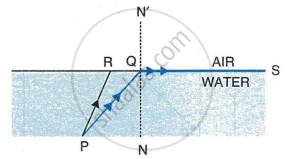
- State the special name given to the angle of incidence ∠PQN of the ray PQ.
- What is the angle of refraction for the refracted ray QS?
- Name the phenomenon that occurs if the angle of incidence ∠PQN is increased.
- The ray PR suffers partial reflection and refraction on the water-air surface. Give reason.
- Draw in the diagram the refracted ray for the incident ray PR and hence show the position of image of the object P by the letter P’ when seen vertically from above.
i) Observe the given figure and answer the following questions.
a) Identify and write the natural process shown in the figure.
b) List the phenomena which are observe in this process.
c) Redraw the diagram and show above phenomena in it.
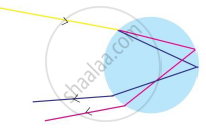
Solve the previous problem if the paperweight is inverted at its place so that the spherical surface touches the paper.
The observation made by Swarali while doing the experiment is given below. Based on these write answers to the questions:
Swarali found that the light ray travelling from the denser medium to rarer medium goes away from the normal. If the angle of incidence (i) is raised by Swarali, the angle of refraction (r) went on increasing. However, after certain value of the angle of incidence the light ray is seen to return back into the denser medium.
Questions:
- What is the specific value of∠i called?
- What is the process of reflection of incident rays into denser medium called?
- Draw the diagrams of three observations made by Swarali.
The diagram below shows a light source P embedded in a rectangular glass block ABCD of critical angle 42°. Complete the path of the ray PQ till it emerges out of the block. [Write necessary angles].
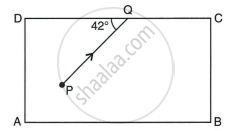
Plot a graph between
Angle of incidence versus angle of reflection,
(a) A ray of monochromatic light enters glass PQRS as shown in the fig. Complete the path of ray till it emerges from the glass. (Critical angle of glass is 420).
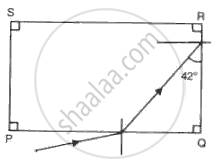
(b) Draw diagram of a prism periscope.
(c) What are the advantages of total internal reflecting prism over plane mirror?
Name the principle on the basis of which optical fibres work.
How does a ray of light bend when it travels from when it is normal to the interface of the two media.
If a ray of light passes from medium I to medium II without any change of direction, what can be said about the refractive indices of these media (angle I is not 0)?
A ray of light incident at an angle of incidence ‘i’ passes through an equilateral glass prism such that the refracted ray inside the prism is parallel to its base and emerges from the prism at an angle of emergence ‘e’.
How is the angle of emergence ‘e’ related to the angle of incidence ‘i’?
How is the critical angle of a material related to its refractive index?
Answer the following question.
Under what conditions are total internal reflection possible? Explain it with a suitable example.
Critical angle of light passing from glass to air is maximum for ____________.
A particle is projected such that the horizontal range and vertical height are equal. Then the angle of projection is :
The outer concentric shell in optic fiber is called ______.
The angle of incidence at which the angle of refraction is Q£ is called the critical angle.
Write any two uses of total internal reflection.
The phenomena involved in the reflection of radiowaves by ionosphere is similar to ______.
Observe the given figure of the raindrop and answer the following questions:
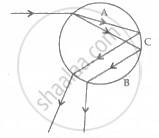
- Label A and B of the given diagram. Why colour will deviate most.
- Name the phenomenon shown in label C.
The angle made by incident ray of light with normal of the reflecting surface is called ______.
- Assertion (A): Propagation of light through an optical fibre is due to total internal reflection taking place at the core-cladding interface.
- Reason (R): Refractive index of the material of the cladding of the optical fibre is greater than that of the core.
Small air bubbles rising up a fish tank appear silvery when viewed from some particular angle is due to the ______.
Name any two phenomena which take place in the formation of a rainbow.
